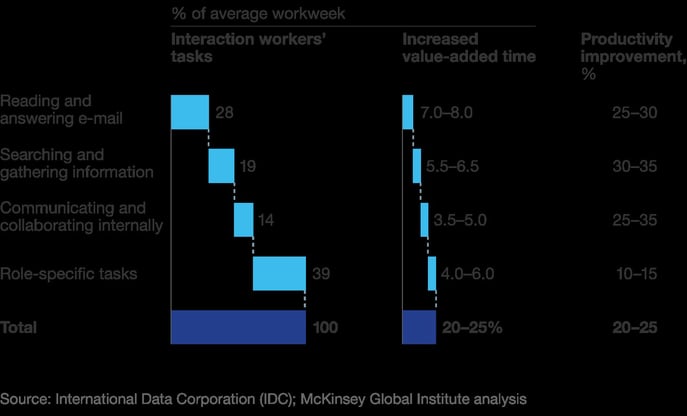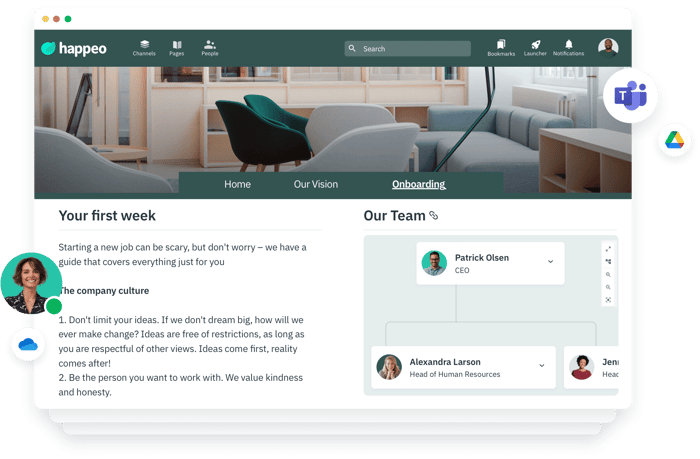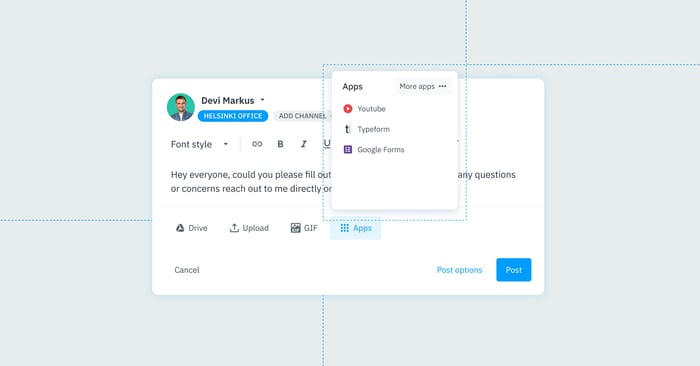
Quick guides Knowledge Management
Knowledge management: A guide for remote and hybrid workforces

13 mins read
Start building your digital home with Happeo
Request a demoQuick guides Knowledge Management
Product
Features
Solutions
Happeo for
Use cases
Resources
Explore
Support
Happeo For
Use cases
Comparisons
Explore
Support
Recent

Jonathan Davies
13 mins read
Table of Contents
As more employees shift to remote work, companies are wrestling with the question: How will everyone find the information they need when they no longer work in the traditional office?
Companies must keep information flowing across different locations and time zones – and they can do that with a knowledge management system.
If you want to improve knowledge management and implement a robust solution for your workforce, then you’re in the right place.
In this guide for remote and hybrid workforces, we will:
Knowledge management is the process of finding, collecting, organizing, retaining, and sharing knowledge and information within an organization.
This knowledge includes information such as:
Picture this: It’s 4 p.m. on a Friday. You’ve only got one more task to finish. And once you find the information you’re looking for, you’ll create a quick chart and drop it into the report that you’re presenting first thing Monday morning.
But you can’t find the information. The one person who might know where it is has already left the office. The clock’s ticking, and you realize you’re not going to get home anytime soon.
It’s a frustrating scenario – and one that may occur more often, with many companies employing hybrid and remote workforces. That’s why companies need a knowledge management solution.
Even before the pandemic, McKinsey found that office-based companies with a robust knowledge management system could reduce search time by 35% and increase productivity by 25%:

If companies want to maximize efficiently, they need to invest in a knowledge management system that helps everyone access and share information.
A knowledge management system has three types of knowledge:
Explicit knowledge is tangible information that’s easy to write down and share, such as employee guidelines, instructions, or market research data found in files, folders, and databases.
Implicit knowledge is understanding how things work, such as how to perform a specific task.
Tacit knowledge comes from personal experience — it’s the practical application of implicit knowledge within an organization. It’s not as easy to extract as it’s more intuitive than explicit knowledge — for example, knowing what tone to use when speaking with certain clients.
Click here to learn more about knowledge management frameworks.
Modern intranets typically don't use traditional hierarchical information structures — they integrate systems and services instead of linking them. As more employees work remotely, intranets can help organizations increase productivity.
Wikis are open-source online encyclopedias, like Wikipedia. Authorized users can edit and improve existing information.
They’re effective for document management and product catalogs, but the data is not always 100% accurate.
Databases allow companies to capture, store, interrogate, and analyze data. Typically, they’re indexed for fast access and have additional security to protect the information. But, they can be expensive to design and implement.
Content management systems store and retrieve vital documents and allow users to upload video and audio. However, they may be too complex for some users.
Knowledge management platforms store and share up-to-date information that everyone can access. In addition, they can fulfill the function of intranet pages, wikis, and content management systems.
Click here to discover the best knowledge management solutions.
We can break down the knowledge management process into five steps.
This is the process of collecting all forms of knowledge, including documents, processes, and the knowledge that exists only in employees’ brains. Part of this process is asking employees what they don’t know about other teams and processes. You might also ask them for any “life hacks” that aren’t on the record (because someone might know which printer is least prone to paper jams).
The next step is to review how and where you store knowledge. For example, do you have old hard paper copies archived in box files, or is everything stored on shared drives in the cloud? Maybe you have a modern intranet or virtual workspace to store knowledge. Either way, you need a method of categorizing the data to be easily accessible to everyone.
The review step weeds out any outdated or unwanted information, such as business accounting records over seven years old. Modern knowledge management systems include a lifecycle management feature to automatically archive expired information.
The next step covers how you’ll share knowledge. For example, some companies distribute knowledge via email, while others use messaging channels.
The final step involves analyzing how your business accesses, uses, and shares knowledge. A modern knowledge management system has built-in analytics to track user engagement. Click here to learn more about the knowledge management process.
Fortune 500 companies lose around $31 billion annually because they don’t have a system for sharing knowledge. Business leaders that implement a knowledge management solution could save roughly $2 million a month for every 4,000 employees.
Here are some other ways knowledge management benefits businesses:
Knowledge management accelerates onboarding and training, because new hires can access how-to videos, HR policies, and other information they need to know.
The seamless self-serve process creates a great first impression, improves retention of new hires, and frees up time for HR and managers to focus on other tasks.

With some employees working remotely, others in the office, and some adopting a hybrid model, it’s more likely knowledge silos will form.
Effective knowledge management can break down, remove, and prevent company silos by instilling a knowledge-sharing culture where everyone can find the information they need.
An effective knowledge management system could increase productivity by up to 25%. With a single source of truth, employees don’t have to waste time searching for information.
Moreover, simplified workflows save time and effort so staff can collaborate, work, and approve tasks more efficiently. Knowledge management organizes work, streamlines information, connects teams, and distributes knowledge.
Employees come and go — you can’t stop that — but effective knowledge management can increase employee retention. It also ensures you retain implicit and tacit knowledge even when a longtime employee moves on.
Effective knowledge management empowers teams to collaborate on projects, forge bonds, share ideas, and communicate freely.
For example, Happeo’s Channels let employees post messages, share files, tag users, comment and interact, and discuss projects as they collaborate. It helps them feel connected, even when working from different locations.

When staff have access to the latest, most relevant information, they can make faster, better-informed decisions. That’s why Happeo’s users experience a 30% increase in decision-making time.
Knowledge management ensures everyone has access to the same information. This transparency promotes a healthy digital culture and provides equal learning opportunities for everyone. The overwhelming majority (84%) of Happeo customers say the system has made it easier to preserve the culture of the company as it grows.
Finding the right knowledge management solution can be challenging. It’s important to review different tools to see if they meet your criteria, and test them before rolling out the software to everyone.
Some employees may not be keen to share their knowledge. Perhaps they want to maintain control of a particular process or function or fear losing their job if other staff know how to complete a specific task. Regardless, you must ensure that everyone shares their knowledge for the solution to succeed.
You may have sensitive information or confidential data that you don’t need to share with everyone or let the general public see. Make sure your knowledge management system has robust security and user roles and permissions to prevent data leaks.
Click here to learn more about the key features of a knowledge management system.
The whole point of a knowledge management system is to centralize up-to-date information. That means when businesses implement a knowledge management system, they should migrate all — not just some — information to their new platform.
Employees need quick access to relevant information. As you roll out your new knowledge management system, schedule some time to walk through how to find information. You could also create a short tutorial video that employees can access any time they need a refresher on how to use the knowledge management system.
Encourage employees to collaboratively edit pages, interact through comments, or tag teammates for input. Consider recognizing and rewarding top contributors to motivate other employees.
As you acquire more knowledge in your system, segmenting the data is increasingly important to make it easier for employees to navigate and understand. Most knowledge management software lets you create spaces for projects, teams, or groups of documents.
Schedule regular audits to ensure content is up to date. If you’re using Happeo, you can also set expiration dates for content or channels that you know won’t be relevant past a certain date.
When you invest in a knowledge management platform, you want to make sure employees are using it (and not reverting to the “old ways” of storing information). Review your analytics regularly to evaluate your employee engagement, see what types of content resonate with workers, and which channels are most popular.
.jpg?width=633&height=337&name=Blog%20-%20Advanced%20Analytics%20(1).jpg)
Click here to learn more about creating a knowledge management strategy.
This depends on the size and structure of your business For example:
A knowledge management framework creates, manages, and distributes various types of knowledge. There are 5 pillars to it:
Knowledge management is the process of acquiring, storing, reviewing, distributing, expanding, and tracking knowledge within the workplace (virtual or otherwise).
As more employees now have a fully remote or hybrid work schedule, it’s vital you have a knowledge management system that everyone can access regardless of location.
The Happeo enterprise knowledge management system makes it easy to collect, retain, share, and find different types of knowledge by:
